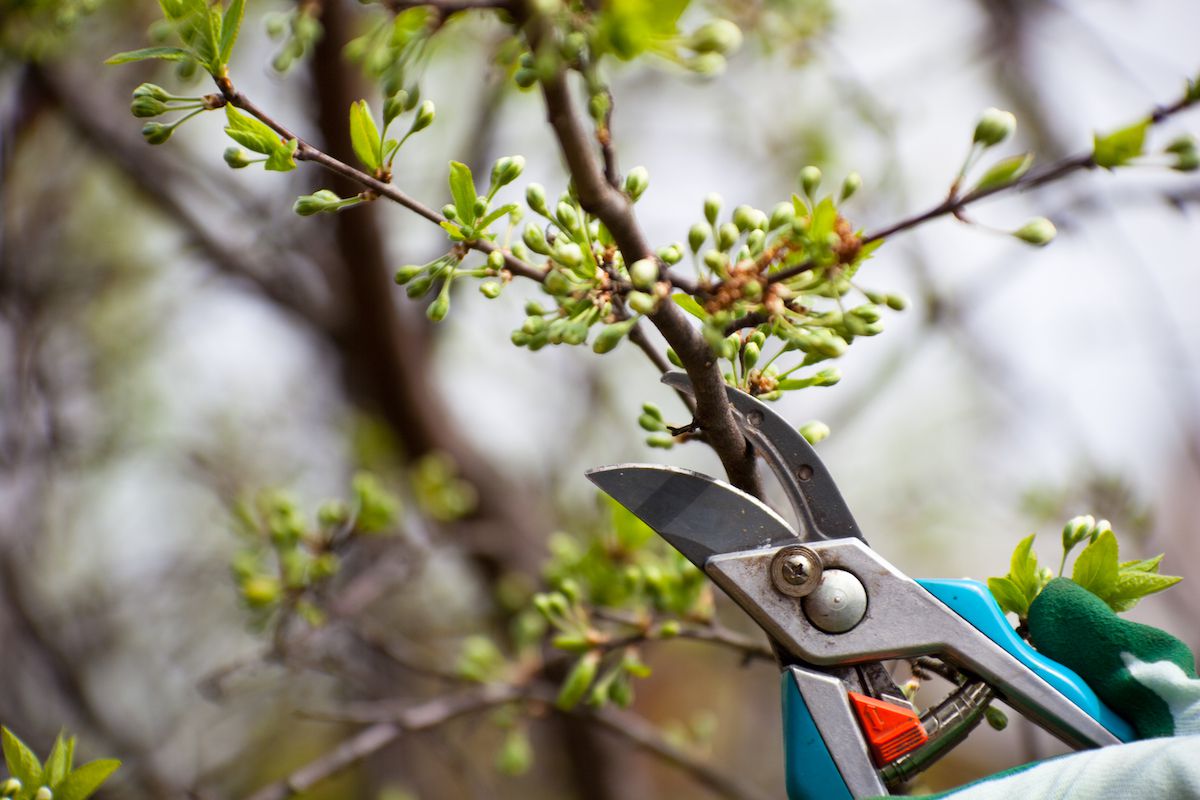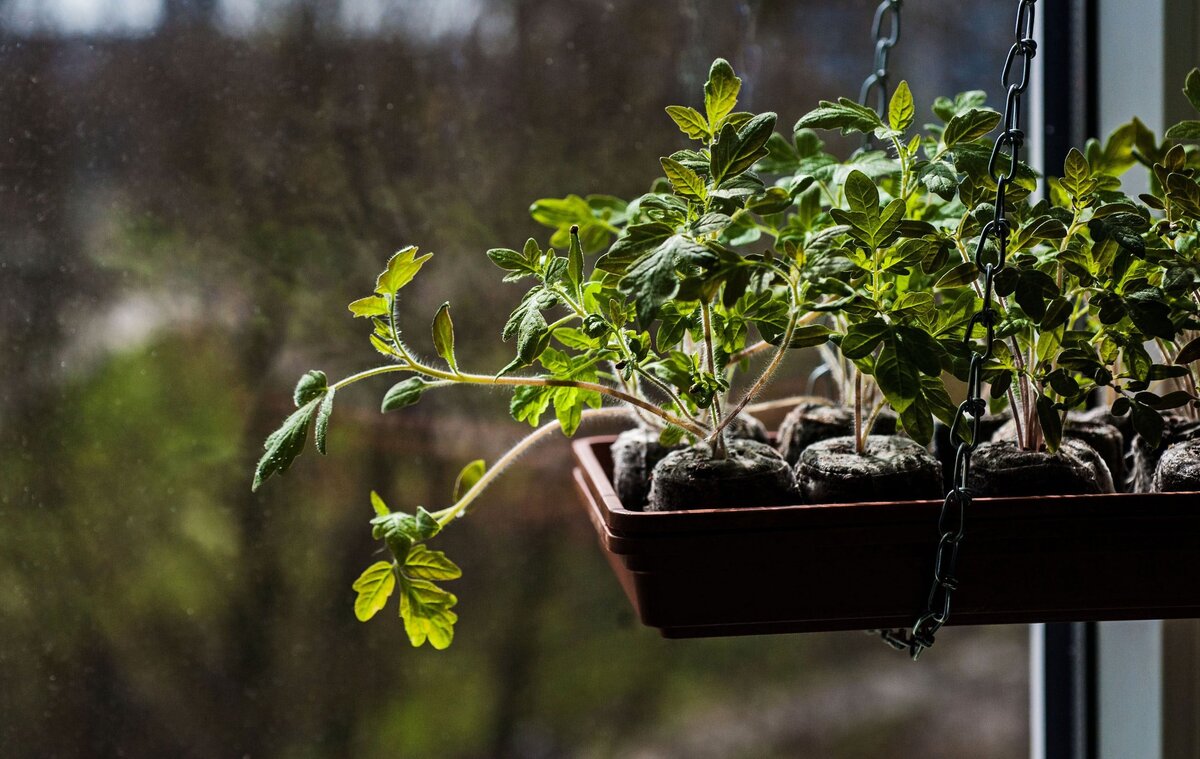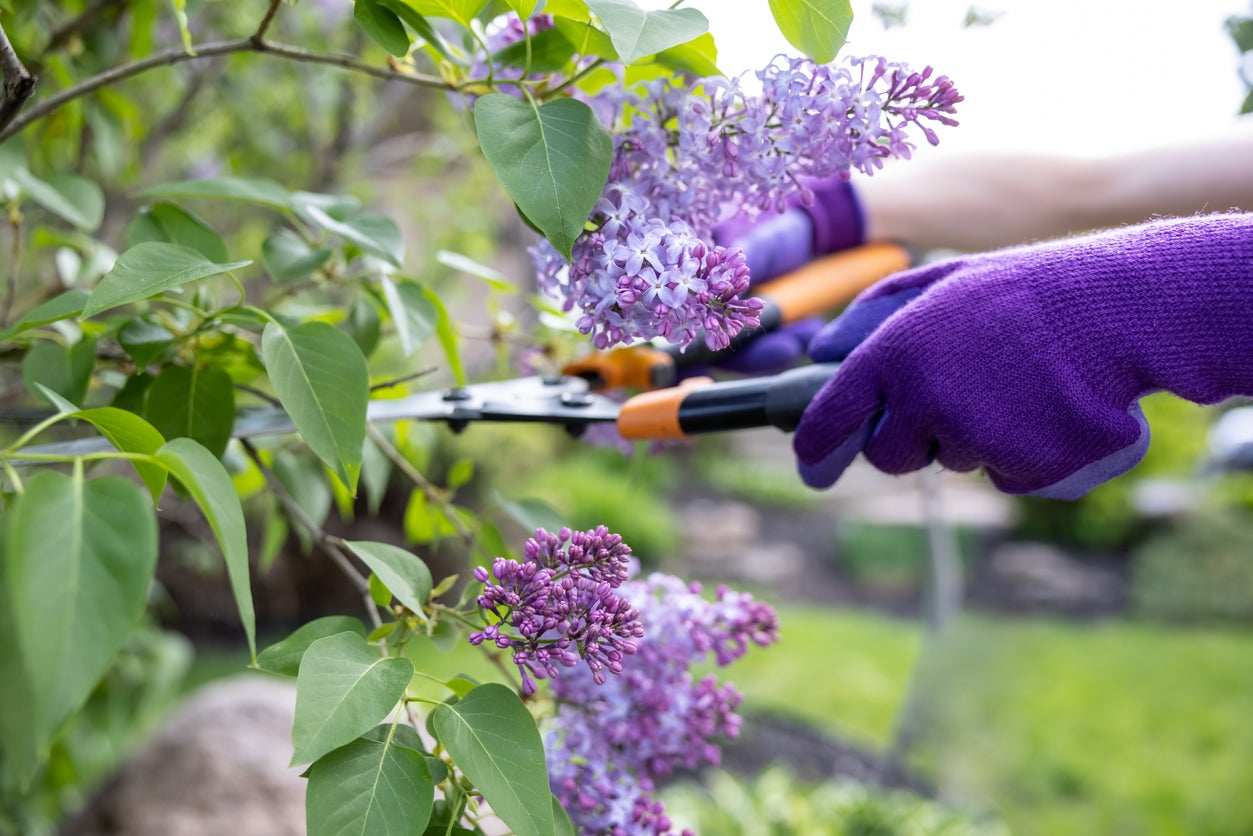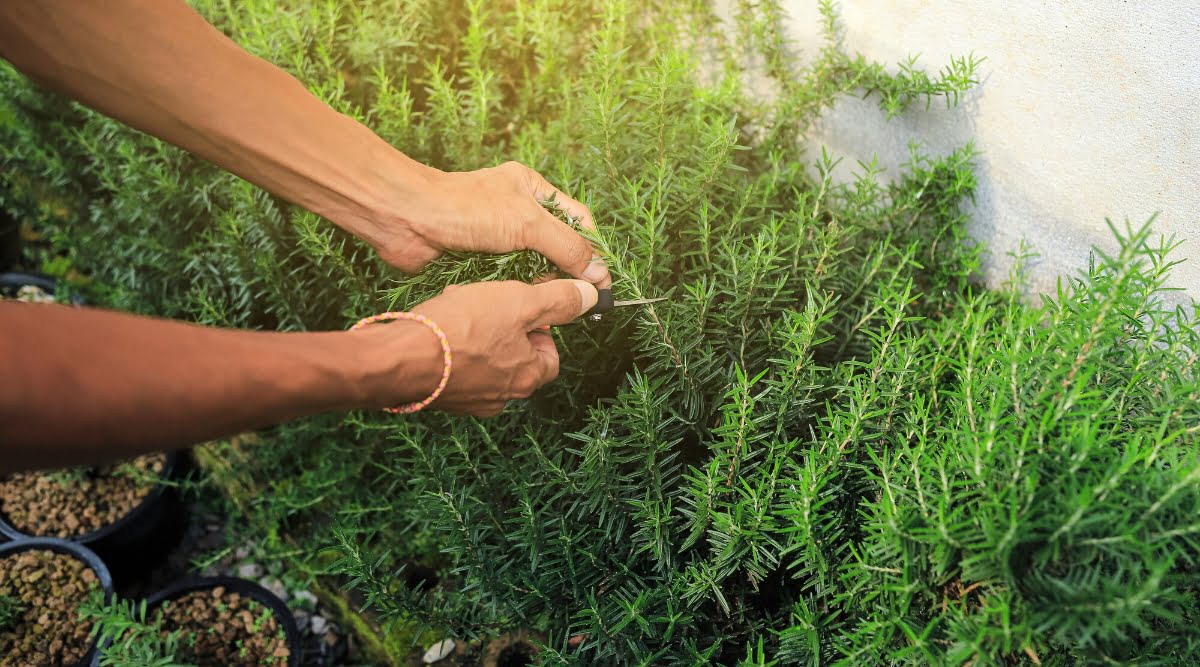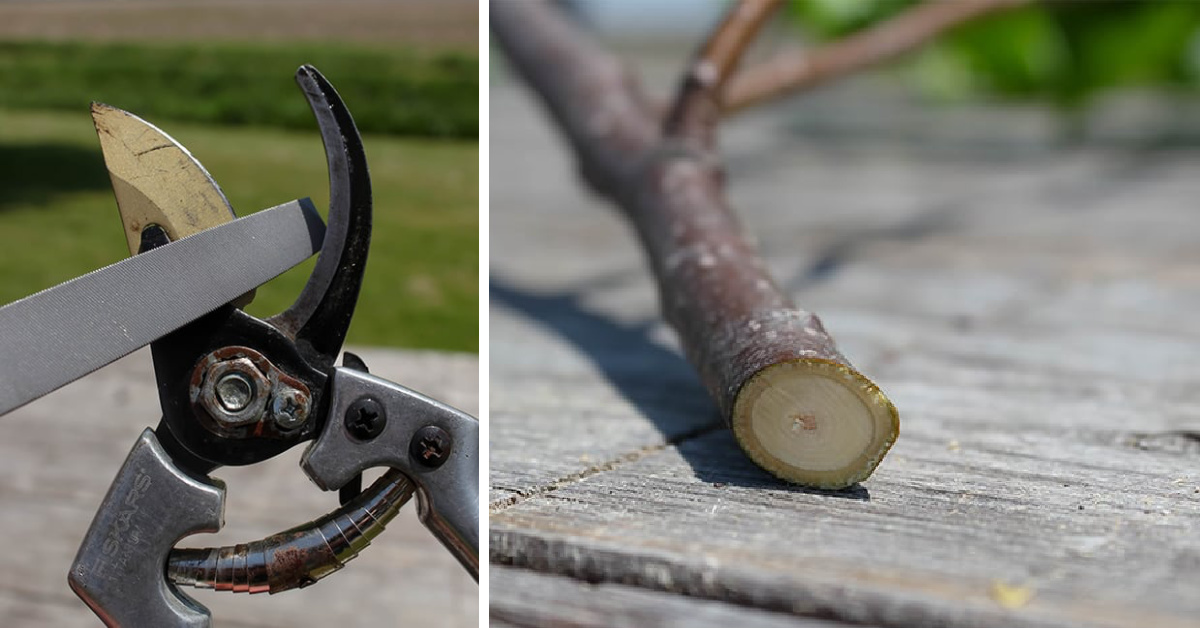Home>Gardening Techniques>Plant Care>What Is Pruning In Plants
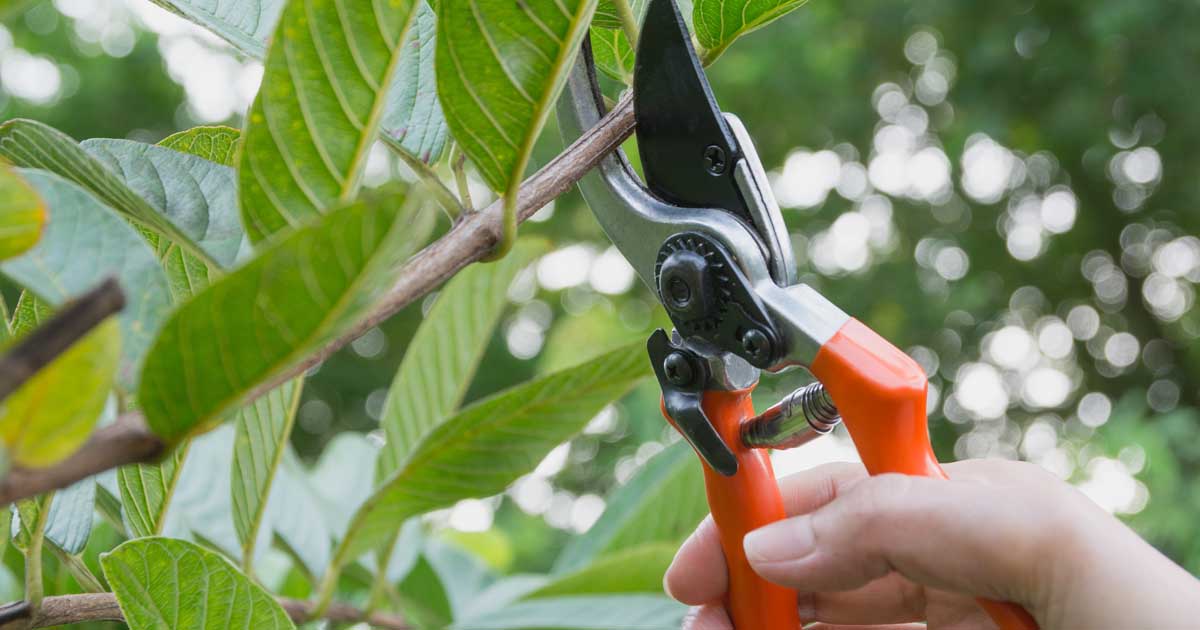

Plant Care
What Is Pruning In Plants
Modified: January 22, 2024
Learn the importance of pruning in plant care and how it promotes healthy growth and improves overall plant appearance. Discover essential techniques and tips for effective pruning.
(Many of the links in this article redirect to a specific reviewed product. Your purchase of these products through affiliate links helps to generate commission for Chicagolandgardening.com, at no extra cost. Learn more)
Table of Contents
Introduction
Welcome to the world of plant care! As a plant enthusiast, you probably already know that taking care of plants involves more than just watering and sunlight. Pruning is an essential part of plant care that helps promote healthy growth and maintain the overall appearance of your plants. Whether you’re a beginner or a seasoned gardener, understanding the art of pruning is crucial for keeping your plants thriving and looking their best.
Pruning is the process of selectively removing specific parts of a plant, such as branches, shoots, or buds. It may sound simple, but pruning requires careful consideration and knowledge about the specific needs and characteristics of each plant. By strategically removing certain parts of the plant, you can encourage new growth, improve air circulation, and shape the plant’s overall structure.
The primary purpose of pruning is to enhance the health and vitality of plants. It helps to remove dead, diseased, or damaged branches, preventing the spread of infections or pests. Additionally, pruning also helps to direct the plant’s energy towards essential areas, such as fruit production or flower development. By removing excess branches or buds, you can promote better nutrient distribution and improve the plant’s overall strength.
There are several benefits to incorporating pruning into your plant care routine. First and foremost, pruning helps to maintain the aesthetic appeal of your plants. It allows you to shape and control their growth, ensuring they fit perfectly into your desired landscape design. Pruned plants also tend to have a more balanced and symmetrical appearance.
Furthermore, pruning plays a crucial role in preventing and managing plant diseases. By removing infected or diseased branches, you can prevent the spread of pathogens and safeguard the health of your other plants. Pruning also helps to improve air circulation around the plant, reducing the risk of fungal issues and improving overall plant health.
Knowing when to prune is just as important as knowing how to prune. The timing can vary depending on the type of plant and the specific pruning objectives. For most plants, it is best to prune during their dormant season, which is typically in late winter or early spring. This period allows the plant to heal and recover before the vigorous growth of the upcoming season.
There are various types of pruning techniques that you can use depending on your plants’ needs. Some common techniques include thinning, heading, rejuvenation, and selective pruning. Each technique serves a different purpose and requires a unique approach based on the plant’s growth habits and desired outcomes.
Definition of Pruning
Pruning is a horticultural practice that involves selectively removing certain parts of a plant, such as branches, shoots, or buds. It is an essential technique used to shape, maintain, and improve the health of plants. The process of pruning requires careful consideration of the plant’s growth habits, specific needs, and aesthetic goals.
Pruning serves several purposes, including removing dead, diseased, or damaged branches to prevent the spread of infections and pests. By eliminating these compromised parts, you can help the plant allocate its resources more effectively and promote healthy growth.
Another primary objective of pruning is to shape plants to achieve a desired form or structure. This is particularly important for trees, shrubs, and hedges, as it helps maintain their appearance and promotes proper growth. Pruning also allows you to control the size of the plant, ensuring it fits within its designated space.
In addition to shaping and maintaining the structure of the plant, pruning can also enhance its overall health and vitality. By removing overgrown or crowded branches, you can improve air circulation and light penetration, reducing the risk of fungal diseases and allowing for more even growth throughout the plant.
Pruning can also be used to increase fruit or flower production. By selectively removing certain branches, you can redirect the plant’s energy towards producing high-quality fruits or vibrant blooms. This technique, known as fruit tree or flower thinning, helps to ensure that the plant’s resources are focused on producing a smaller number of higher-quality fruits or flowers.
It is important to note that pruning should be done with caution and with a clear understanding of the plant’s specific needs. Improper pruning can lead to an array of problems, including stunted growth, increased susceptibility to diseases, and unbalanced aesthetics. Therefore, it is crucial to learn about the specific requirements and growth habits of each plant species before attempting any pruning.
By mastering the art of pruning, you can transform your plants into beautiful, healthy specimens that thrive in their environment. Through the strategic removal of branches and shoots, you can shape the plant’s growth, improve its health, and enhance its overall appearance.
Purpose of Pruning
Pruning serves several important purposes in plant care. It is a practice that goes beyond simply shaping plants or maintaining their appearance. Understanding the purpose behind pruning helps gardeners make informed decisions and implement effective pruning techniques. Here are some key purposes of pruning:
Promoting Health: One of the primary purposes of pruning is to promote the health and vitality of plants. By removing dead, diseased, or damaged branches, you can prevent the spread of infections and pests. Pruning also improves air circulation and light penetration, which in turn reduces the risk of fungal diseases and promotes overall plant health. By eliminating crowded or crossing branches, you can direct the plant’s energy towards healthier growth, ensuring that essential nutrients reach all parts of the plant.
Shaping and Structure: Pruning plays a pivotal role in shaping plants and maintaining their desired form or structure. Whether it’s creating an aesthetically pleasing shape or controlling the size of a plant, pruning helps achieve specific design goals. Pruning major branches can help develop a well-balanced plant structure, making it more resistant to wind damage. It is particularly important for trees, shrubs, and hedges to be pruned properly to ensure they grow in a controlled manner and fit within the available space.
Encouraging Flower and Fruit Production: Proper pruning can significantly impact the quantity and quality of flowers or fruits produced by a plant. By selectively removing certain branches, you can redirect the plant’s energy towards producing more flowers or fruits. Thinning branches can improve air circulation and light penetration to the remaining flowers or fruits, resulting in better development and larger yields. Some plants also benefit from pruning to encourage secondary or repeat blooms.
Rejuvenation: For older or overgrown plants, rejuvenation pruning can help renew their vigour and promote healthy growth. This technique involves removing a significant portion of the plant to stimulate new growth from the base. Rejuvenation pruning can be done gradually over several years to prevent shock and allow the plant to regenerate properly. It is commonly used for shrubs, such as lilacs and spireas, that become woody and less productive over time.
Controlling Pests and Diseases: Pruning can aid in controlling pests and diseases by removing infected or infested branches. By pruning these affected parts, you can prevent the spread of pathogens and limit the damage caused by pests. Additionally, thinning branches to increase airflow and sunlight exposure creates an environment that is less favourable for the development of fungal diseases.
Improving Aesthetics: Pruning also plays a role in enhancing the overall aesthetics of plants and landscapes. By removing unsightly or awkwardly growing branches, you can create a more visually pleasing appearance. Pruning can also help maintain a specific shape or form that complements the garden design or architectural features of the surrounding environment.
Understanding the purpose behind pruning is vital for successful plant care. By tailoring your pruning techniques to the specific needs and goals of each plant, you can not only improve their health and structure but also enhance their beauty and productivity.
Benefits of Pruning
Pruning offers a wide range of benefits for plants and gardeners alike. From promoting healthy growth to improving the overall appearance of plants, pruning plays a crucial role in plant care. Understanding the benefits of pruning can help you make informed decisions and achieve long-term success in your gardening endeavors. Here are some key advantages of pruning:
Promotes Healthy Growth: Pruning helps promote the health and vitality of plants by removing dead, diseased, or damaged branches. This prevents the spread of infections and pests, allowing the plant to allocate its resources more efficiently. Pruning also improves air circulation and light penetration, reducing the risk of fungal diseases and promoting overall plant health. By removing crowded or crossing branches, you can direct the plant’s energy towards healthier growth, ensuring that essential nutrients reach all parts of the plant.
Enhances Aesthetic Appeal: Pruning is an effective way to enhance the aesthetic appeal of plants and landscapes. By selectively removing unsightly or overgrown branches, you can create a more visually pleasing appearance. Pruning allows you to shape plants to achieve a desired form or structure, ensuring they fit harmoniously within their surroundings. Well-pruned plants often have a balanced and symmetrical appearance, enhancing the overall beauty of your garden or outdoor space.
Controls Size and Growth: Pruning is essential for controlling the size and growth of plants. By removing excess branches, you can prevent overcrowding and ensure that the plant fits within its designated space. This is particularly important for trees, shrubs, and hedges, as it helps maintain their shape and prevents them from encroaching on nearby structures or other plants. Pruning also influences the direction of growth, allowing you to shape the plant’s form and guide its growth in a desired direction.
Improves Flower and Fruit Production: Pruning can significantly impact the quantity and quality of flowers or fruits produced by a plant. By selectively removing certain branches, you can redirect the plant’s energy towards producing more flowers or fruits. Thinning branches improves air circulation and light penetration, resulting in better development and larger yields. Pruning also helps to remove competing branches and redirects nutrients to the remaining flowers or fruits, ensuring they receive the necessary resources for optimal growth.
Increases Longevity: Regular pruning can help extend the lifespan of plants. By removing dead, damaged, or diseased branches, you reduce the risk of infection or pest infestation, which can weaken the plant over time. Pruning also helps to improve the structural integrity of trees, making them more resistant to wind damage or breakage during heavy storms. Proper pruning techniques ensure that the plants grow in a balanced and healthy manner, promoting longevity and ensuring they remain an integral part of your landscape for years to come.
Controls Pests and Diseases: Pruning can aid in controlling pests and diseases by removing infected or infested branches. By promptly pruning these affected parts, you can prevent the spread of pathogens and limit the damage caused by pests. Additionally, pruning helps improve air circulation and sunlight exposure, creating an environment that is less favorable for the development of fungal diseases. Regular pruning as part of an overall plant care routine can help keep your plants healthy and minimize the presence of pests and diseases.
Encourages New Growth: Pruning stimulates new growth in plants. When you strategically remove certain branches or buds, the plant responds by producing new shoots and leaves. This is especially important for rejuvenating older or overgrown plants that may have become less productive. By pruning and promoting new growth, you can revitalize the plant and encourage it to thrive.
By understanding and harnessing the many benefits of pruning, you can effectively care for your plants and create a beautiful, healthy, and harmonious outdoor space.
When to Prune
Knowing when to prune is essential to ensure the success and health of your plants. The timing of pruning can vary depending on the type of plant, its growth habits, and the specific objectives of your pruning. Pruning at the right time allows the plant to heal properly and promotes new growth. Here are some general guidelines for when to prune:
Winter Dormancy: For many plants, especially deciduous trees and shrubs, it is often best to prune during their winter dormant season. This is when the plants are not actively growing, and the lack of foliage makes it easier to assess and shape their structure. Pruning during winter dormancy helps to stimulate new growth when spring arrives. It is generally recommended to prune late in the winter or early in the spring, before the plant starts its active growth.
After Flowering: Some plants, such as flowering shrubs and perennials, should be pruned after they have finished flowering. Pruning immediately after flowering allows the plant to produce new growth and set buds for the next flowering season. Avoid pruning these plants in late summer or fall, as it can remove the developing flower buds and reduce next year’s display.
Spring Pruning: Certain plants, such as fruit trees and some ornamental shrubs, benefit from spring pruning. Spring pruning is typically done to shape the plant, remove dead or damaged branches, and encourage new growth. It is important to prune just before the plant starts its active growth, allowing it to heal quickly and prevent excessive sap flow.
Summer Pruning: Summer pruning is often done on specific plants that produce new growth throughout the growing season. This includes some ornamental trees, such as birches and maples, as well as some flowering shrubs. Summer pruning can help control the size and shape of these plants, as well as remove any unwanted suckers or water sprouts.
Pruning During Growth: Some plants, particularly those that flower on new wood, can be pruned during their active growth. This includes many flowering shrubs, such as hydrangeas, potentillas, and butterfly bushes. Pruning these plants during their growing season allows you to shape their growth, maintain their size, and remove any spent flowers to promote continuous blooming.
It is important to note that not all plants follow these general guidelines, and there may be specific timing requirements for certain species. It is always recommended to research the specific needs of each plant before pruning. Additionally, it is best to avoid pruning during extreme weather conditions, such as freezing temperatures or hot, dry periods, as it can stress the plants and hinder their ability to heal properly.
Observing the growth patterns and requirements of your plants will help you determine the most appropriate time to prune. By adhering to the optimal pruning schedule for each species, you can ensure proper healing, stimulate new growth, and maintain the overall health and appearance of your plants.
Different Types of Pruning Techniques
Pruning is not a one-size-fits-all practice. Different plants and their specific needs require different pruning techniques. Understanding the various pruning techniques available allows you to tailor your approach to each plant and achieve the desired outcomes. Here are some common types of pruning techniques:
Thinning: Thinning involves selectively removing entire branches back to their point of origin or to a main branch. This technique is often used to improve airflow, reduce overcrowding, and decrease the weight of branches. Thinning helps promote better light penetration and reduces the risk of fungal diseases. It also allows the plant to focus its energy on healthier growth and improves overall plant health.
Heading: Heading involves cutting back the terminal portion of a branch to stimulate new growth. This technique is commonly used to control the size and shape of shrubs and hedges. Heading back encourages lateral branching and results in a denser, more compact plant. However, it is important to consider the plant’s growth habits and avoid excessive heading, as it can lead to the development of weak, upright growth.
Rejuvenation: Rejuvenation pruning is a more drastic technique used to renew overgrown or older plants. It involves removing a significant portion of the plant, often down to the ground level, to stimulate new growth from the base. This technique is useful for shrubs that have become woody or less productive over time. Rejuvenation pruning is typically done gradually over several years to prevent shock and allow the plant to regenerate properly.
Selective Pruning: Selective pruning involves the targeted removal of specific branches or shoots to shape the overall form of the plant. It is often used to maintain the natural character of the plant or to correct any growth irregularities. Selective pruning requires careful consideration and a keen eye for detail, as it aims to create balance, symmetry, and a pleasing overall shape.
Espaliering: Espaliering is a specialized pruning technique used to train plants, usually fruit trees, along a flat surface, such as a wall or fence. The branches are carefully pruned and shaped to create a structured pattern. Espaliering helps maximize space in small gardens, improves fruit production, and creates an attractive feature. It requires regular pruning and training to maintain the desired shape.
Deadheading: Deadheading involves the removal of spent flowers from plants. This technique is used to encourage continuous blooming and prevent the formation of seeds, which can divert the plant’s energy away from producing new flowers. Regular deadheading helps plants redirect their resources towards new growth and promotes a prolonged flowering season.
It is important to note that the specific pruning techniques employed will depend on the type of plant, its growth habits, and the desired outcomes. Some plants may require a combination of techniques or specialized pruning practices. Always research the specific needs and recommendations for each plant before applying any pruning techniques.
By understanding and employing the appropriate pruning techniques, you can shape, maintain, and enhance the health and appearance of your plants. Regular and well-executed pruning will contribute to the long-term success and beauty of your garden.
Tools for Pruning
Pruning requires the use of proper tools to ensure clean cuts, minimize damage to plants, and make the task more efficient. Having the right tools for the job not only makes pruning easier but also helps promote the health and appearance of your plants. Here are some essential tools for pruning:
Pruning Shears: Pruning shears, also known as hand pruners or secateurs, are a must-have tool for any gardener. These hand-held tools are designed for cutting small branches, twigs, and stems with precision and ease. There are two main types of pruning shears: bypass and anvil. Bypass pruners have a curved blade that slides past a counter blade, resulting in a clean and precise cut. Anvil pruners have a straight blade that cuts against a flat surface, making them suitable for tougher branches and deadwood.
Loppers: Loppers are used for cutting larger branches that cannot be easily handled by pruning shears. They have long handles with a cutting mechanism similar to pruning shears, enabling you to reach higher branches with better leverage. Loppers come in various sizes and designs, including bypass and anvil styles. The choice of loppers depends on the thickness of the branches you intend to prune.
Pruning Saw: A pruning saw is a specialized tool used to cut through thick branches. Unlike regular saws, pruning saws have smaller, sharper teeth designed to cut through wood efficiently. They usually have a curved or folding blade for better control and access to tight spots. Pruning saws are ideal for removing larger and harder-to-reach branches that pruning shears or loppers cannot handle.
Hedge Shears: Hedge shears are specifically designed for trimming and shaping hedges and shrubs. These tools have long, straight blades that make even, precise cuts across multiple branches at once. Hedge shears help maintain the neat appearance of hedges and promote dense growth. It is important to keep hedge shears clean and sharp to avoid crushing or tearing the branches during pruning.
Pole Pruners: Pole pruners are used for cutting branches that are out of reach, such as those at the top of trees. They consist of a long pole with a pruning saw or bypass pruner at the end. Some pole pruners have telescopic handles, allowing you to reach even higher branches without the need for a ladder. Pole pruners are especially useful for pruning tall trees and avoiding the risks associated with climbing.
Hand Saws: Hand saws are versatile tools that come in handy for pruning larger branches. They have longer, coarse teeth that can cut through thick branches quickly. Hand saws are suitable for situations where using loppers or pole pruners is not feasible or practical. They provide more control and precision compared to power tools when removing larger branches.
Gloves and Safety Gear: When pruning, it is important to protect your hands with a sturdy pair of gardening gloves. Gloves provide a grip, protect against thorns, and prevent blisters. Depending on the size and type of pruning tasks, you may also need safety goggles or a face shield to protect your eyes from debris and ear protection to reduce noise from power tools.
Proper maintenance and regular cleaning of pruning tools are essential. Sharpening the blades and disinfecting the tools after each use helps prevent the spread of diseases and ensures clean cuts. It is also important to choose tools that are comfortable to handle and appropriate for your specific pruning needs.
By equipping yourself with the right tools and taking proper care of them, you can make your pruning tasks more efficient, effective, and enjoyable.
Pruning Tips and Techniques
Pruning is both an art and a science that requires careful consideration and proper technique. By following some essential tips and techniques, you can ensure successful pruning and promote the health and aesthetics of your plants. Here are some key tips to keep in mind when pruning:
Understand the Plant: Different plants have different pruning requirements. Take the time to research and understand the specific needs and growth habits of each plant before pruning. Consider factors such as flowering patterns, growth rates, and the best time to prune for optimal results.
Use Proper Tools: Select the appropriate pruning tools for each task. Ensure that your tools are clean, sharp, and in good working condition. Clean cuts made with sharp tools promote faster healing and reduce the risk of disease transmission. Using the right tool for the job also makes pruning easier and more efficient.
Make Clean Cuts: When making cuts, ensure that they are clean and precise. Avoid tearing or splintering the bark, as this can create entry points for diseases and pests. Position your tools at the proper angle and make smooth, decisive cuts. For larger branches, use the three-cut method: make an undercut first, followed by a top cut, and then a final cut to remove the stub.
Prune Outward-Facing Buds: When performing heading cuts, aim to prune just above an outward-facing bud or branch. This encourages new growth to grow outward, promoting a more open and balanced structure. Pruning to an inward-facing bud can cause the new growth to crowd inward, leading to a dense and tangled plant.
Avoid Overpruning: Be cautious not to overprune, as this can weaken the plant and hinder its ability to produce energy through photosynthesis. Prune no more than 25% of the plant’s total canopy in a single season, and avoid removing more than one-third of a branch’s length. Pruning excessively can lead to stress, reduced vigor, and an unbalanced plant.
Remove Dead, Diseased, or Damaged Branches: Identify and remove any dead, diseased, or damaged branches as part of regular maintenance. These branches not only detract from the appearance of the plant but can also spread diseases to healthy parts. Pruning out these problem areas helps redirect the plant’s resources towards healthier growth.
Consider the Plant’s Growth Habit: Pay attention to the natural growth habit of the plant when pruning. Some plants, such as conifers, have limited ability to regenerate new growth from old wood. Others, like roses, benefit from aggressive pruning to stimulate new blooms. Understanding each plant’s unique growth habit helps you make informed decisions and achieve desired results.
Observe the Three D’s: Regularly inspect your plants and prune based on the three D’s: Remove dead, damaged, and diseased branches. This keeps the plant healthy, prevents further spread of diseases, and improves the overall appearance.
Step Back and Evaluate: Take a step back and evaluate the overall shape and structure of the plant as you prune. Assess how your pruning cuts impact the plant’s form and ensure a balanced and aesthetically pleasing result. If needed, make additional adjustments to maintain symmetry and control the plant’s growth.
Prune at the Right Time: Follow proper timing guidelines for pruning, considering the specific requirements of each plant. Pruning at the wrong time can interfere with growth patterns, reduce flowering or fruit production, and harm the overall health of the plant. Research the optimal timing for pruning your specific plant species.
Remember that pruning is an ongoing process and should be done strategically and thoughtfully. Regular pruning and maintenance throughout the plant’s lifecycle help promote healthy growth and ensure a well-shaped, productive plant.
Common Mistakes to Avoid in Pruning
Pruning is a skill that requires knowledge and practice. While it can greatly benefit your plants, there are common mistakes that gardeners often make when pruning. By being aware of these mistakes, you can avoid potential damage to your plants and ensure successful pruning. Here are some common pruning mistakes to avoid:
Improper Pruning Cuts: Making improper cuts is one of the most common mistakes in pruning. Avoid leaving stubs when removing branches, as they can become entry points for diseases and pests. On the other hand, avoid cutting too close to the main stem, as it can damage the branch collar and hinder proper healing. Make clean cuts just beyond the branch collar or the branch bark ridge to ensure proper healing and minimize the risk of infection.
Overpruning: Overpruning can be detrimental to plant health. Removing too much foliage and branches can weaken the plant, disrupt its growth patterns, and reduce its ability to photosynthesize and produce energy. Avoid overpruning by following the general guidelines of not removing more than 25% of the plant’s total canopy in a single season. Prune selectively and consider the plant’s overall structure and health before making any cuts.
Pruning at the Wrong Time: Pruning at the wrong time can have negative effects on plant growth and flowering. Each plant has specific timing requirements for pruning. Pruning at the wrong time can disrupt the plant’s natural growth cycle, inhibit flower and fruit production, or cause excessive stress. Research the appropriate pruning times for your specific plants and follow the guidelines accordingly.
Not Properly Disinfecting Tools: Failing to disinfect pruning tools between cuts or between plants can lead to the spread of diseases. Bacteria, fungi, or pathogens can be introduced into healthy tissue through contaminated tools, causing infections and further damage. Regularly clean and disinfect your tools between cuts and between plants using rubbing alcohol, bleach solution, or specialized disinfectants to minimize the risk of disease transmission.
Ignoring Plant Structure: Pruning without considering the natural growth habit and structure of the plant can result in an unbalanced or distorted appearance. It’s important to work with the natural form of the plant, aiming to maintain a healthy and aesthetically pleasing structure. Take into account the plant’s branching patterns, growth habit, and dimensions before making pruning decisions.
Using Dull or Improper Tools: Working with dull or improper tools can make pruning more difficult and lead to messy cuts. Dull tools can tear or crush branches instead of making clean cuts, increasing the risk of damage and disease. Ensure that your pruning tools are sharp and suitable for the size and type of branches you are cutting. Clean and maintain your tools regularly to keep them in optimal condition.
Pruning During Extreme Weather Conditions: Pruning during extreme weather conditions, such as freezing temperatures or hot, dry periods, can stress the plants and hinder their ability to heal properly. Extreme temperatures can make it difficult for plants to recover from pruning cuts and can increase the risk of damage. Aim to prune during milder weather conditions when plants are better able to handle the stress of pruning.
Ignoring Safety Measures: Pruning can be physically demanding, particularly when handling larger branches or using power tools. Ignoring safety measures can lead to injuries. Always wear gloves, safety goggles, and appropriate protective gear when necessary. Take proper precautions when using ladders or climbing to reach high branches. Follow safety guidelines and work within your physical capabilities to avoid accidents.
Relying on Looks Alone: While aesthetics are important, relying solely on the appearance of a plant when pruning can lead to incorrect pruning decisions. Consider the health, growth habit, and purpose of the plant before making any cuts. Prune for plant health and functionality, focusing on removing dead, diseased, or damaged branches, as well as improving airflow and overall plant structure.
By avoiding these common pruning mistakes and following proper techniques, you can ensure healthy growth, promote plant vitality, and create well-maintained and visually appealing landscapes.
Conclusion
Pruning is an essential practice in plant care that contributes to the health, vitality, and aesthetics of your plants. By understanding the purpose of pruning, the different pruning techniques available, and the proper timing for pruning, you can make informed decisions when it comes to maintaining and shaping your plants. Pruning promotes healthy growth, controls size, improves flowering and fruiting, and helps prevent the spread of diseases.
When pruning, it’s important to use the right tools and make clean cuts to minimize damage and promote proper healing. Avoid common pruning mistakes such as overpruning, improper cuts, and pruning at the wrong time. By following pruning tips and techniques, you can effectively shape and maintain the structure of your plants while promoting their health and longevity.
Remember that pruning is not a one-time task, but an ongoing process. Regular observation, evaluation, and maintenance are necessary to ensure the continued well-being of your plants. By incorporating proper pruning into your plant care routine, you can create a beautiful, thriving garden that brings you joy and satisfaction.
So, embrace the art of pruning, equip yourself with the necessary knowledge and tools, and unleash your creativity as you shape and cultivate your plants. Your efforts will be rewarded with healthy, vibrant, and visually appealing plants that enrich your indoor and outdoor spaces.
